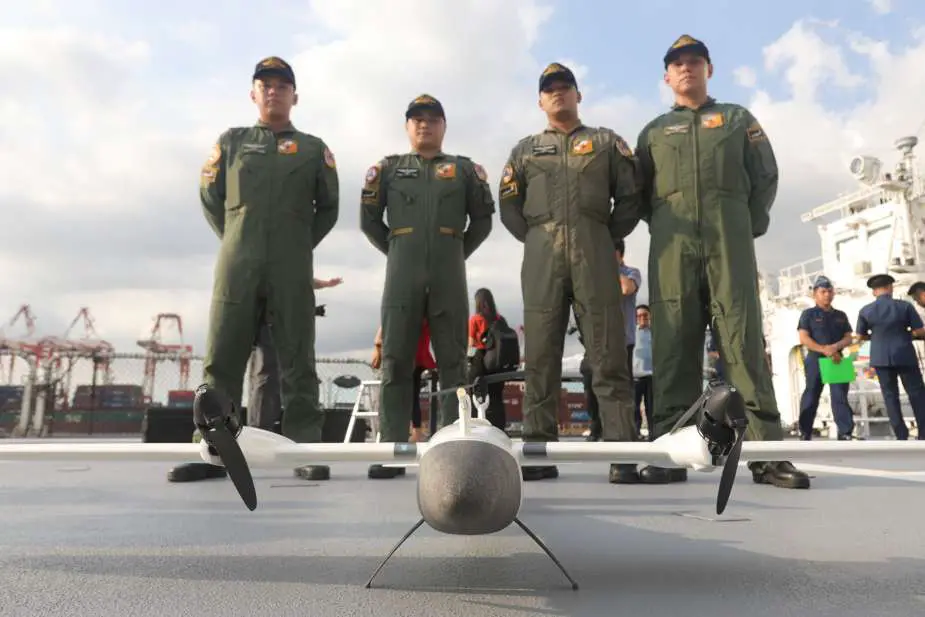Breaking news
Philippine Coast Guard to receive additional drones from Germany.
On January 12, 2024, the Philippine Coast Guard (PCG) and Germany announced an extension of their collaboration in various areas, including law enforcement, anti-piracy training, and technological advancements. Germany has pledged to donate a minimum of four drones to enhance the PCG's capabilities, following their previous contribution of two F90+ drones in 2022 for Coast Guard Aviation Force pilot training.
Follow Navy Recognition on Google News at this link
 Germany has pledged to donate a minimum of four drones to enhance the reconnaissance capabilities of the Philippine Coast Guard. (Picture source: PCG)
Germany has pledged to donate a minimum of four drones to enhance the reconnaissance capabilities of the Philippine Coast Guard. (Picture source: PCG)
Germany provided two Trinity F90+ drones to the PCG in 2022 through the German Corporation for International Cooperation (GIZ). The additional drones, part of a €129 million assistance package from the German government, will strengthen the PCG's operations in disaster response and relief efforts, maritime surveillance for drug interdiction, and combating illegal fishing activities. These drones will also contribute to providing imagery for reconnaissance purposes and generating high-resolution maps for assessing oil spills or investigating potential unlawful activities in regions like the West Philippine Sea and Benham Rise.
As of early 2024, the maritime situation between the Philippines and China is marked by ongoing tensions related to territorial disputes in the South China Sea. The Philippines has announced plans to upgrade its outposts in this region, focusing on enhancing the living conditions for its troops stationed there. This includes the installation of facilities such as desalination machines and communication equipment, particularly on strategically important features like Thitu Island and Second Thomas Shoal. The Philippines is also aiming to strengthen its naval capabilities with additional ships, radars, drones, and aircraft to patrol the disputed waters more effectively.
These actions are a response to increased activities by China in the South China Sea, where it has made numerous incursions into areas claimed by the Philippines. Notably, China's activities around Second Thomas Shoal, which lies within the Philippines' exclusive economic zone, have included attempts to impede Philippine naval operations. Reports indicate that Chinese vessels have frequently positioned themselves in a way that complicates or restricts access for Philippine vessels, especially in areas around key features like Second Thomas Shoal. This tactic resembles a form of blockade, creating challenges for the Philippines in accessing these maritime zones.
Additionally, there have been incidents where Chinese vessels have physically collided with Philippine boats. These collisions are not just isolated events but are seen as part of a broader pattern of China enforcing its territorial claims in the region and challenging the operational presence of the Philippines. The presence of Chinese naval and coast guard ships in the disputed areas has further heightened tensions. These vessels have been observed closely following, shadowing, and in some instances, physically blocking the path of Philippine vessels.
The Trinity F90+, manufactured by the German company Quantum Defense, is an eVTOL (electric Vertical Take-Off and Landing) fixed-wing mapping Unmanned Aircraft System (UAS) designed for professionals in mapping and data collection. It offers a 90-minute flight time, extended endurance for uninterrupted missions, and a range of integrated cameras, including the Sony UMC-R10C, Sony RX1R II, Oblique D2M, Qube 240 LiDAR, MicaSense RedEdge-P, and MicaSense Altum-PT.
The Trinity F90+ comes with the QBase 3D software for mission planning and control, including QBase Modem Longrange 2.4GHz and cables for communication with the drone. The drone package includes a GNSS module, an iBase Reference GNSS base station, a USB ADS-B receiver set, an air data probe, a remote control (RC) transmitter, a battery pack, a battery charging station, an anti-collision strobe, position lights, and an anemometer.
Optional system supplements and software modules are available, including an ADS-B out transponder, a DLSII kit, LiDAR integration kits, remote ID kits, a calibrated reflectance panel (CRP), and various CloudStation software modules.
Regarding technical specifications, it has a maximum take-off weight of 5.0 kg, a flight time exceeding 90 minutes (with variations based on altitude and weather), a range of 100 km, and a maximum flight altitude of 4500 m. The command and control range is 5-7.5 km, with an optimal cruise speed of 17 m/s. Additionally, the F90+ drone has a wingspan of 2.394 m, while the transport case weighs 22.3 kg (including three batteries).























